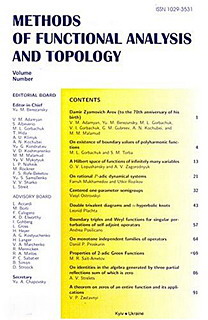Vol. 21 (2015), no. 2
Yurij Makarovych Berezansky (to 90th birthday anniversary)
MFAT 21 (2015), no. 2, 101–103
101–103
Conservative L-systems and the Livšic function
S. Belyi, K. A. Makarov, E. Tsekanovskiĭ
MFAT 21 (2015), no. 2, 104-133
104-133
We study the connection between the classes of (i) Livsic functions $s(z),$ i.e., the characteristic functions of densely defined symmetric operators $\dot A$ with deficiency indices $(1, 1)$; (ii) the characteristic functions $S(z)$ of a maximal dissipative extension $T$ of $\dot A,$ i.e., the Mobius transform of $s(z)$ determined by the von Neumann parameter $\kappa$ of the extension relative to an appropriate basis in the deficiency subspaces; and (iii) the transfer functions $W_\Theta(z)$ of a conservative L-system $\Theta$ with the main operator $T$. It is shown that under a natural hypothesis {the functions $S(z)$ and $W_\Theta(z)$ are reciprocal to each other. In particular, $W_\Theta(z)=\frac{1}{S(z)}=-\frac{1}{s(z)}$ whenever $\kappa=0$. It is established that the impedance function of a conservative L-system with the main operator $T$ belongs to the Donoghue class if and only if the von Neumann parameter vanishes ($\kappa=0$). Moreover, we introduce the generalized Donoghue class and obtain the criteria for an impedance function to belong to this class. We also obtain the representation of a function from this class via the Weyl-Titchmarsh function. All results are illustrated by a number of examples.
Around Ovsyannikov's method
MFAT 21 (2015), no. 2, 134–150
134–150
We study existence, uniqueness, and a limiting behavior of solutions to an abstract linear evolution equation in a scale of Banach spaces. The generator of the equation is a perturbation of the operator which satisfies the classical assumptions of Ovsyannikov's method by a generator of a $C_0$-semigroup acting in each of the spaces of the scale. The results are (slightly modified) abstract version of those considered in [10] for a particular equation. An application to a birth-and-death stochastic dynamics in the continuum is considered.
Some applications of almost analytic extensions to operator bounds in trace ideals
MFAT 21 (2015), no. 2, 151–169
151–169
Using the Davies-Helffer-Sjostrand functional calculus based on almost analytic extensions, we address the following problem: Given a self-adjoint operator $S$ in $\mathcal H$, and functions $f$ in an appropriate class, for instance, $f \in C_0^{\infty}(\mathbb R)$, how to control the norm $\|f(S)\|_{\mathcal B(\mathcal H)}$ in terms of the norm of the resolvent of $S$, $\|(S - z_0 I_{\mathcal H})^{-1}\|_{\mathcal B(\mathcal H)}$, for some $z_0 \in \mathbb C\backslash\mathbb R$. We are particularly interested in the case where $\mathcal B(\mathcal H)$ is replaced by a trace ideal, $\mathcal B_p(\mathcal H)$, $p \in [1,\infty)$.
On the structure of solutions of operator-differential equations on the whole real axis
MFAT 21 (2015), no. 2, 170–178
170–178
We consider differential equations of the form $\left(\frac{d^{2}}{dt^{2}} - B\right)^{m}y(t) = f(t)$, $m \in \mathbb{N}, \ t \in (-\infty, \infty)$, where $B$ is a positive operator in a Banach space $\mathfrak{B}, \ f(t)$ is a bounded continuous vector-valued function on $(-\infty, \infty)$ with values in $\mathfrak{B}$, and describe all their solutions. In the case, where $f(t) \equiv 0$, we prove that every solution of such an equation can be extended to an entire $\mathfrak{B}$-valued function for which the Phragmen-Lindel\"{o}f principle is fulfilled. It is also shown that there always exists a unique bounded on $\mathbb{R}^{1}$ solution, and if $f(t)$ is periodic or almost periodic, then this solution is the same as $f(t)$.
Fractional contact model in the continuum
Anatoly N. Kochubei, Yuri G. Kondratiev
MFAT 21 (2015), no. 2, 179–187
179–187
We consider the evolution of correlation functions in a non-Markov version of the contact model in the continuum. The memory effects are introduced by assuming the fractional evolution equation for the statistical dynamics. This leads to a behavior of time-dependent correlation functions, essentially different from the one known for the standard contact model.
The projection spectral theorem and Jacobi fields
MFAT 21 (2015), no. 2, 188–198
188–198
We review several applications of Berezansky's projection spectral theorem to Jacobi fields in a symmetric Fock space, which lead to L\'evy white noise measures.


